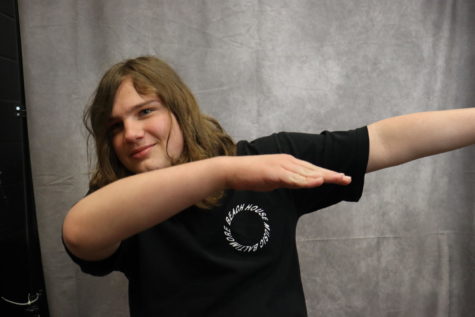In Mr. Zainea’s AP Language class, juniors were recently given a unique opportunity to test their knowledge of the class’s required skills: brainstorming, designing, and ultimately pitching promotional materials for a fictional school board candidate. The project culminated with students setting up stands in the media center and creating a makeshift gallery, presenting campaigns to a constant stream of students, teachers, and administrators.
“We had to create promotional materials for that candidate as if they were running in a real election,” junior Sophia Getty said. “I think our class had about 150 people come and look at our work. The majority of the people in our hour were probably students, but we also got some pretty big people in the community, like Mr. Kapolka – the superintendent. It was awesome.”
The project was conceived by AP Language teacher John Zainea, whose class is centered around exploring rhetoric in its many forms. Throughout the course, students rotate through a series of essays, quizzes, and analyses, but the project provides a uniquely real-world lens to reinforce the class’s central theme: rhetoric is ordinary.
“We’re trying to find ways to connect our learning to the real world and make assessments more authentic,” Zainea said. “So, not just pencil-and-paper and multiple-choice tests, but things that actually challenge you to think about how your learning matters outside of high school. As I was looking at AP Language and thinking of ways to do that, this project came up as a way to connect learning about rhetoric to something we go through almost every year: elections. It’s a very real thing that has a nice overlap with what we’re studying.”
When crafting their projects, students were given near-complete creative freedom to design their candidate’s appearance, personality, and – most importantly – platforms and ideas.
“We wanted a female candidate because our team was mostly women,” Getty said. “We wanted her to be an advocate for inclusion and mental health because we think those are issues that can be improved on. It was based on our personal experiences, so we wanted to give [the administration] a good idea of what the student body is thinking.”
Nearly every student took advantage of the project’s less restrictive format to tackle relevant issues. Candidates’ platforms, however, remained remarkably diverse.
“My candidate argued for more flexible due dates at the end of the week,” junior Hunter Hartin said. “That’s important to me, that’s more applicable to what it’s like in college. We also campaigned for backpacks in class, since it would help us feel more prepared. Also, free transportation to community center classes. I’ve had to go there in the winter, and it’s slippery.”
Despite providing this platform, its potential to invoke change was an unintentional bonus in what was initially meant to provide an academically focused challenge.
“In all honesty, my priority as an AP Language teacher is teaching about rhetoric, right?” Zainea said. “So, as I designed the project, it was initially to provide that opportunity. But I think it’s really important that students learn how to advocate for their interests and what they care about. We talked a lot in that class about educating the whole person, so it’s not just about learning content – it’s about figuring out your beliefs and being able to act based on them. You have the superintendent or the president of the school board sitting right in front of you wanting to hear your ideas, and a number of them have told me how refreshing it is. Maybe that was initially a secondary concern in the project, but it’s become, in my mind, one of the really valuable parts.”
Though the project has seen several changes over the years (including larger group sizes and – further mirroring real elections – sub-committee work), Zainea introduced an even more dramatic shift this time around: the ability for students to incorporate AI. Group members now had the option to prompt AI to create first drafts of stump speeches and public apologies, two of the assignment’s most time-consuming portions.
“We used AI to create the image of our person,” Hartin said. “It was weird because he had six fingers on each hand. I think that technology can be useful, but you just can’t use it for everything. It works best as a guiding point.”
Though controversial, AI usage continues to become more and more prevalent in classroom life – whether teachers approve of it or not. Zainea’s experimentation with this technology represents a growing trend of instructor-encouraged application, although many educators continue to question its benefits.
“AI will be a part of the job for most future careers,” Zainea said. “So while I’m a little leery of turning over the task of writing to computers, I know that that’s just where the world is heading. Students must get chances to learn how to use it effectively and responsibly as a tool. I heard a lot of students say that when they used AI, they got experience with designing prompts, which is really important. But I don’t think anybody just took what it gave them and used that. Almost every group tweaked or revised it. And that’s a really valuable skill, almost as valuable as learning how to do the first draft. I don’t know if it was perfect, but it at least helped us dip our toes.”
Additionally, the project took on a significant amount of added relevance during 2024’s contentious presidential election. With students completing material just days before results were announced, analysis and creation of campaign materials took on new significance.
“I think that it kind of expanded our viewpoints on the election,” Getty said. “Instead of just being receivers of all this rhetoric and promotional material, we were actually thinking of how we could create it and make it appealing to others. Determining our campaign’s overall approach provided a really interesting perspective.”
To match the contentious election, the project’s variety of sample materials for students to draw inspiration from was slightly tweaked.
“I try to keep the sources contemporary,” Zainea said. “So this year, I added Twitter accounts for Vice President Harris and the current leaders of the House and Senate. I added President Trump’s Twitter account too, since he was a major candidate. I wanted people to see the actual politicians running for office using the same sorts of things that they were, but also I didn’t want this to become another place to just debate Harris versus Trump. So I was intentional about bringing in examples from other elections, and not just making it a project about 2024’s.”
Candidate creation was, undoubtedly, a lengthy, multi-faceted process, but the intended takeaway for students is clear: rhetoric is, in fact, very ordinary.
“I’ve been reading students’ reflections, and it’s interesting to see what they take away,” Zainea said. “But a favorite for me is when students realize just how nuanced and complex an idea rhetoric is. The words I use in an individual sentence are going to strike different audiences differently. It goes beyond language and into how people look, act, and present themselves. It’s a very multi-layered concept.”


![Wherefore Art Thou [Acting that Way], Romeo?](https://chsbleuprint.com/wp-content/uploads/2025/06/neuroscience-1200x800.jpg)





